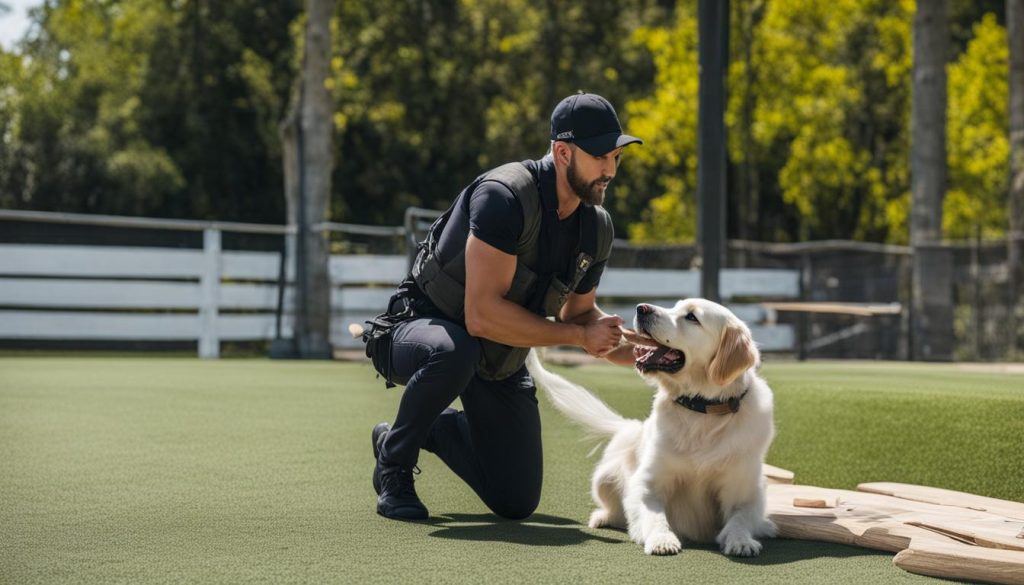To teach your dog to bark at strangers, you need to establish a foundation of basic commands such as ‘come’, ‘sit’, ‘down’, and ‘stay’. These commands will ensure your dog’s obedience and establish your role as the Alpha. You will also require a leash, treats, and a helper to assist with the training.
By teaching your dog to bark at strangers, you can enhance your home’s security and deter potential intruders. It is a valuable skill that can be developed through consistent training and reinforcement.
Key Takeaways:
- Establish a foundation of basic commands to establish your role as the Alpha.
- Use treats and positive reinforcement during training sessions.
- Teach your dog to bark on command to enhance security.
- Consider incorporating a hand signal to reinforce the behavior.
- Be mindful of your neighbors and practice in short, focused sessions.
The Importance of Teaching Your Dog to Bark on Command
Barking is a natural way for dogs to communicate, but it can also be a nuisance if not properly controlled. By teaching your dog to bark on command, you can have better control over their barking behavior. This can be beneficial in situations where you want your dog to alert you to the presence of strangers or potential intruders. Utilizing various dog training techniques and behavior training methods, you can modify your dog’s barking behavior and teach them to bark on command.
When it comes to barking behavior modification, consistency is key. By teaching your dog the command to bark on cue, you are giving them a clear signal for when it is appropriate to bark. This can help prevent excessive barking and provide you with a way to manage their behavior. Through consistent training and reinforcement, your dog can learn to associate the command with the behavior of barking, enabling you to have better control over their actions.
Behavior training for dogs is essential for their overall well-being and obedience. Teaching your dog to bark on command is just one aspect of their training journey. By incorporating this command into their training routine, you are not only enhancing their skills but also strengthening your bond with them. Try to be patient, use positive reinforcement techniques, and practice regularly to ensure success in teaching your dog to bark on command.
| Benefits of Teaching Your Dog to Bark on Command |
|---|
| Improved Security: Your dog can alert you to the presence of strangers or potential intruders, enhancing your home’s security. |
| Controlled Barking: By teaching your dog to bark on command, you can better manage their barking behavior and prevent excessive noise. |
| Enhanced Communication: Teaching your dog to bark on command allows for clearer communication between you and your furry companion, strengthening your bond. |
Teaching Your Dog to Bark on Command
To effectively teach your dog to bark on command, you should follow a structured training process that incorporates rewards and consistency. By utilizing positive reinforcement techniques and incorporating the “speak” command into your dog’s obedience training, you can successfully teach them to bark on command.
Start by creating a command word, such as “speak”, and pair it with an action that encourages your dog to bark, like knocking on a door or ringing a bell. When your dog barks in response to the action, immediately praise them and offer a reward. Repeat this process consistently, gradually reducing the need for the action and relying solely on the command word.
I would recommend to be patient throughout the training process and to avoid punishing your dog for barking or not barking on command. Instead, focus on rewarding the desired behavior and reinforcing the command word. With consistent training, your dog will learn to associate the command with the action of barking and will respond reliably when given the command.
Training Tips for Teaching Your Dog to Bark on Command
- Make training sessions fun and engaging to keep your dog motivated.
- Use high-value treats or toys as rewards to increase your dog’s motivation.
- Be consistent with your command word and reward system to avoid confusing your dog.
- Gradually increase the difficulty of the training by introducing distractions or practicing in different environments.
- Always end the training session on a positive note, even if your dog is not consistently barking on command. Celebrate their progress and continue to reinforce the behavior.
| Command Word | Action | Reward |
|---|---|---|
| “Speak” | Knocking on a door | Treat or praise |
| “Speak” | Ringing a bell | Treat or praise |
| “Speak” | Doorbell sound | Treat or praise |
By following these training tips and staying consistent with your approach, you can successfully teach your dog to bark on command. To put it simply, the key to effective training is patience, positive reinforcement, and a strong bond with your furry friend!

Adding a Hand Signal to the Command
Once your dog has mastered the verbal command for barking, you can enhance their training by adding a hand signal. A hand signal can further reinforce the behavior and provide a visual cue for your dog to bark on command. It can be especially useful in situations where verbal commands may be difficult to hear or if you want to give your dog a clear signal even from a distance.
A commonly used hand signal involves starting with an open hand, palm facing the dog, and repeatedly closing your four fingers against your thumb. This gesture mimics the mouth movement of barking and can effectively communicate the desired behavior to your dog. By consistently pairing the hand signal with the verbal command, your dog will learn to associate the two and respond accordingly.
| Verbal Command | Hand Signal |
|---|---|
| “Speak!” | Open hand, palm facing the dog, repeatedly closing fingers against thumb |
When introducing the hand signal, you should continue reinforcing the verbal command and reward your dog for the desired behavior. As your dog becomes more familiar with the hand signal, you can gradually rely less on the verbal command and solely use the hand signal to elicit the barking response. This will help solidify the association between the hand signal and the behavior.
Tips for Training “Speak”
Training a dog to bark on command can be an exciting and useful skill to teach your furry friend. Whether you want your dog to alert you to the presence of strangers or simply enjoy the fun of a barking trick, here are some valuable tips to ensure successful training:
Consistency is Key
Consistency is crucial when training your dog to bark on command. Use the same verbal cue, such as “speak” or “bark”, every time you want your dog to perform the behavior. Consistency also applies to rewarding the desired behavior promptly and consistently, reinforcing the association between the command and the action. Reward your dog with treats, praise, or play each time they obey the command to bark.
Short and Engaging Training Sessions
Keep training sessions short and engaging to maintain your dog’s interest and prevent boredom or distraction. Aim for multiple short sessions throughout the day, rather than one long session. This approach helps to avoid mental and physical fatigue and keeps the training process enjoyable for both you and your dog. Try to end each session on a positive note, celebrating your dog’s progress and accomplishments.
Avoid Excessive Barking
While teaching your dog to bark on command may encourage vocalization, you should prevent excessive barking. Only reward barking when you ask your dog to bark, to avoid reinforcing unwanted behavior throughout the day. By differentiating between the “speak” command and regular barking, you can maintain control over your dog’s vocalization and prevent noise disturbances. Be mindful of your neighbors and training environment, ensuring a considerate training process.
By following these tips and being patient and consistent, you can successfully train your dog to bark on command. Try to use positive reinforcement and make the training process enjoyable for both you and your furry companion. With time and practice, your dog will master the “speak” command and impress everyone with their new skills!

Utilizing the “Speak” Command for Various Purposes
Training your dog to bark on command can have practical applications beyond just a fun trick. By teaching your dog to bark at strangers, you can enhance the security of your home and have a reliable way of detecting potential intruders. But the “speak” command can also be used for other purposes.
Using “Speak” as an Alert Signal
Once your dog has mastered the command, you can use it as a signal to let you know if someone is approaching your home. Whether it’s the sound of footsteps, a knock on the door, or the doorbell ringing, your dog’s bark can alert you to the presence of someone you may not be expecting. This can be particularly useful if you live alone or in a neighborhood with limited security measures.
Teaching “Whispering”
Beyond just barking, you can modify the “speak” command to teach your dog to bark at a lower volume. This is often referred to as “whispering” and can be useful in situations where you want your dog to alert you without causing a disturbance. By using a softer tone or lowering the intensity of their bark, your dog can still signal you without drawing too much attention.
| Benefits of Utilizing the “Speak” Command | Examples |
|---|---|
| Enhanced home security | If someone approaches your home, your dog’s bark can act as a deterrent. |
| Improved responsiveness | Your dog will learn to respond to the command consistently, ensuring they alert you when needed. |
| Peace of mind | Knowing that your dog will alert you to any potential threats can provide a sense of security and peace of mind. |
With proper training and reinforcement, the “speak” command can be a valuable tool for helping your dog communicate important information to you. Whether it’s detecting strangers or signaling the need to go outside, utilizing this command can strengthen your bond with your furry friend and provide you with an added layer of security.

Incorporating Training into the AKC Trick Dog Program
The AKC Trick Dog program offers a fantastic opportunity to showcase your dog’s skills and provide a structured approach to training. By incorporating the “speak” command into your training regimen, you can work towards earning your dog’s Trick Dog title. This program recognizes various commands and tricks, including the ability to bark on command.
To participate in the AKC Trick Dog program, your dog must complete ten tricks, or five tricks if they have already earned their Canine Good Citizen title. This program is a wonderful way to challenge your dog’s abilities and strengthen your bond through training.
Training your dog to bark on command is a valuable skill that can be showcased in the AKC Trick Dog program. It demonstrates your dog’s obedience and ability to respond to different commands. By following the training techniques mentioned earlier in this article, you can effectively incorporate the “speak” command into your dog’s repertoire and work towards achieving their Trick Dog title.
| Benefits of Incorporating Training into the AKC Trick Dog Program | How to Incorporate Training into the AKC Trick Dog Program |
|---|---|
|
|
Incorporating the “speak” command into the AKC Trick Dog program not only showcases your dog’s talents but also enhances their overall training and behavior. It provides a structured and goal-oriented approach to training, allowing you to mark your dog’s progress and achievements. Try to practice regularly, reinforce desired behaviors, and have fun along the way!

Teaching Your Dog to Bark at the Doorbell or Knock
To enhance your dog’s ability to alert you to the presence of strangers, you can further train them to bark at the sound of the doorbell or a knock on the door. This training is especially useful for home security and can be incorporated into your dog’s obedience training.
To start the training process, you will need the assistance of a helper who can simulate the doorbell or knock while you give the command for your dog to speak. Begin by having your dog on a leash and in a controlled environment near the door. Then, have your helper ring the doorbell or knock on the door, and as your dog barks, reinforce the behavior by providing verbal praise and a reward. Repeat this process multiple times, gradually increasing the difficulty level by having your dog practice the command in various scenarios, such as different doors or when you are in different rooms.
Consistency and repetition are key in teaching your dog to bark at the doorbell or knock. You should always give the command to speak when the doorbell or knock occurs to establish the association between the sound and the desired behavior. Additionally, you should continue reinforcing the behavior with praise and rewards to ensure its consistency.
| Training Tips | Benefits |
|---|---|
| Use a consistent command such as “speak” or “alert” when teaching your dog to bark at the doorbell or knock. | Enhances your home security by alerting you to the presence of strangers or potential intruders. |
| Gradually increase the difficulty level by practicing the command in different scenarios to ensure your dog’s response is consistent. | Teaches your dog to differentiate between regular noises and potential threats, preventing excessive barking. |
| Reinforce the behavior with verbal praise and rewards to motivate your dog and ensure the desired response. | Strengthens the bond between you and your dog and encourages obedience training. |
By following these training techniques and incorporating them into your dog’s obedience training, you can effectively teach your dog to bark at the doorbell or knock. This skill can provide an added layer of security for your home while also furthering your dog’s obedience skills and strengthening your bond.

Final Thoughts
Training your dog to bark at strangers is a valuable skill that can enhance their safety and the security of your home. By following proper training techniques and reinforcing desired behavior, you can teach your dog to bark on command effectively.
Try to consider the importance of obedience training and the proper use of the command to prevent excessive barking. Consistency and patience are key to successfully modifying your dog’s barking behavior.
Through practice and dedication, you can teach your dog to bark at intruders when needed, providing an added layer of security. Utilize the tips and techniques mentioned in this article to ensure a successful training process and a well-trained canine companion.
FAQ
What are the basic commands I should teach my dog before teaching them to bark at strangers?
You should establish a foundation of basic commands such as ‘come’, ‘sit’, ‘down’, and ‘stay’ to establish your role as the Alpha and your dog’s obedience.
What supplies do I need to teach my dog to bark at strangers?
You will need a leash, treats, and a helper to assist with the training.
Why is teaching my dog to bark on command beneficial?
By teaching your dog to bark on command, you can have better control over their barking behavior, which can be useful in situations where you want them to alert you to the presence of strangers or potential intruders.
How do I teach my dog to bark on command?
The process involves rewarding them for barking when prompted, using a verbal command like “speak!” and reinforcing the behavior with a treat or toy.
Can I use a hand signal along with the verbal command?
Yes, adding a hand signal can further reinforce the behavior. A commonly used hand signal involves repeatedly closing your four fingers against your thumb.
How do I prevent excessive and nuisance barking?
Only reward barking when you ask your dog to bark, and try to capture and mark only a single bark to avoid encouraging excessive barking.
Can I modify the command to teach my dog to bark at a lower volume?
Yes, you can modify the command to teach your dog to bark at a lower volume, known as “whispering”.
Are there any programs that recognize the “speak” command?
Yes, the AKC Trick Dog program recognizes the “speak” command as one of the tricks your dog can learn to earn their Trick Dog title.
How can I train my dog to bark at the sound of the doorbell or a knock?
With the assistance of a helper, have them ring the doorbell or knock while giving the command for your dog to speak. When your dog barks, have the helper praise them.
Why is teaching my dog to bark at strangers important for their safety and home security?
Teaching your dog to bark at strangers can enhance your home’s security and alert you to potential intruders, keeping your dog and your home safe.






